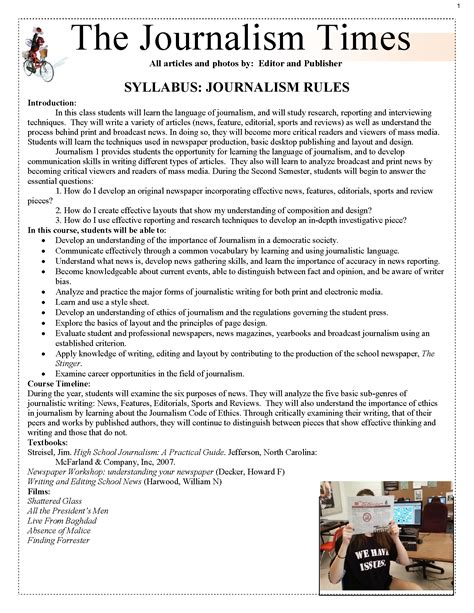Introduction
High school journalism is an invaluable opportunity to develop essential skills in writing, critical thinking, and communication. By engaging in diverse sub-assignments, students can expand their journalistic perspectives, hone their crafts, and prepare for success in college and beyond.

Storytelling Sub-Assignments
1. Feature Article:
– Craft a compelling narrative that showcases the perspectives of individuals or explores a timely issue.
– Interview sources, gather data, and weave different voices into a cohesive story.
2. In-Depth Investigative Report:
– Conduct extensive research, uncover facts, and present them in a balanced and unbiased manner.
– Identify an issue of public concern, interview experts, and draw conclusions based on credible evidence.
Analytical Sub-Assignments
3. News Analysis:
– Analyze current events, identify trends, and provide context for readers.
– Interpret data, draw connections, and present insights that help readers understand complex issues.
4. Op-Ed Essay:
– Present an informed opinion on a controversial topic, supported by well-reasoned arguments.
– Consider multiple perspectives, research evidence, and articulate a clear thesis statement.
Multimedia Sub-Assignments
5. Photojournalism:
– Use visual storytelling techniques to capture the essence of a story or event.
– Develop an eye for composition, lighting, and perspective to create impactful images.
6. Video Journalism:
– Produce short video segments that convey information, entertain, or raise awareness.
– Learn the basics of videography, editing, and storytelling through captivating visuals.
Specialty Sub-Assignments
7. Sports Journalism:
– Cover local sporting events, interview athletes and coaches, and provide insightful commentary.
– Develop a strong understanding of sports rules, terminology, and the impact of sports on society.
8. Arts and Culture Criticism:
– Review artistic performances, exhibitions, or cultural events.
– Analyze and critique artistic quality, relevance, and cultural significance.
9. Science and Technology Journalism:
– Write about scientific discoveries, technological advancements, and their implications for society.
– Interview experts, translate complex concepts into clear language, and inform readers about the latest in science and technology.
Sub-Assignment Idea Generator
To brainstorm new sub-assignment ideas, consider using the word “DISCOVER“:
- Do something different, such as exploring an unconventional topic or trying a new format.
- Investigate a problem or issue that affects your community.
- Share a story that has never been told before.
- Create a multimedia project that combines different elements.
- Observe your surroundings and identify topics for analysis or commentary.
- Venture into a specific field or genre that you are passionate about.
- Embark on a research project that allows you to develop new insights.
- Reflect on your own experiences and write about them from a journalistic perspective.
Table 1: Pain Points and Motivations
| Pain Points | Motivations |
|---|---|
| Lack of real-world experience | Develop practical skills and make a difference |
| Limited access to resources | Increase knowledge and expand horizons |
| Fear of writing | Improve communication and build confidence |
| Lack of diversity in topics | Explore different perspectives and expand knowledge |
| Time constraints | Manage time effectively and prioritize assignments |
Table 2: Step-by-Step Approach
| Step | Description |
|---|---|
| 1. Identify Your Interests: Choose topics that you are passionate about or that you want to learn more about. | |
| 2. Research Your Topic: Gather information from credible sources, including books, articles, interviews, and firsthand observations. | |
| 3. Develop an Outline: Plan the structure of your sub-assignment, including the introduction, body paragraphs, and conclusion. | |
| 4. Write a Draft: Compose your sub-assignment in clear and concise language, using strong evidence to support your arguments. | |
| 5. Revise and Edit: Proofread your work carefully for errors in grammar, spelling, and punctuation. | |
| 6. Submit Your Sub-Assignment: Meet the deadline and present your work in a professional manner. |
Table 3: Pros and Cons
| Pros | Cons |
|---|---|
| Real-world experience | Time constraints |
| Development of critical thinking skills | Limited access to resources |
| Improved communication abilities | Fear of writing |
| Expansion of knowledge | Lack of diversity in topics |
| Preparation for college and beyond | Pressure to produce high-quality work |
Table 4: Sub-Assignment Types and Skills Developed
| Sub-Assignment Type | Skills Developed |
|---|---|
| Feature Article | Storytelling, interviewing, research |
| In-Depth Investigative Report | Research, analysis, critical thinking |
| News Analysis | Analysis, interpretation, bias detection |
| Op-Ed Essay | Argumentation, persuasion, research |
| Photojournalism | Visual storytelling, composition, perspective |
| Video Journalism | Videography, editing, storytelling |
| Sports Journalism | Sports knowledge, interviewing, commentary |
| Arts and Culture Criticism | Artistic analysis, critique, cultural awareness |
| Science and Technology Journalism | Scientific literacy, translation, research |
Conclusion
High school journalism offers an abundance of sub-assignment opportunities that cater to diverse interests and aspirations. By embracing these sub-assignments, students can hone their journalistic skills, broaden their perspectives, and prepare for future success in the field of communication. With creativity, dedication, and a desire to discover, high school journalists can unlock their potential and make a meaningful impact on their communities and beyond.
